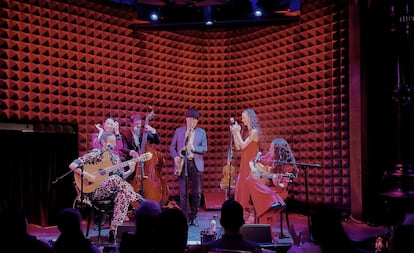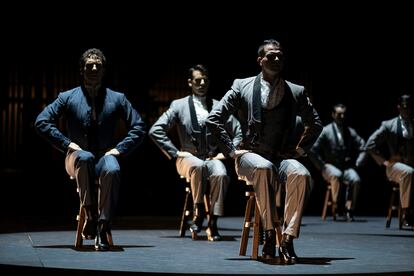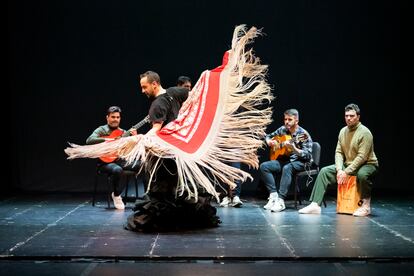Flamenco takes over New York: ‘Just like in Seville!’
Avant-garde forms of the popular genre hailing from southern Spain have now taken firm root in the Big Apple

Audiences in New York and other large U.S. cities have changed the way they think about flamenco music over the last 20 years. “They have moved away from the stereotype of an exotic dance with young women in polka-dot dresses dancing with tall, handsome men who stamp their feet a lot and look very macho,” said music entrepreneur Robert Browning, founder of the World Music Institute, who is now 83 years old and whose retirement in 2011 made it to the cultural pages of The New York Times. “At the age of 70, he gracefully retires, leaving a significant mark on the musical tapestry of New York,” the paper wrote back then. Browning and Miguel Marín co-founded the Flamenco Festival of New York, now in its 23rd year. The festival will pay tribute to the 10-year anniversary of the death of flamenco master Paco de Lucía. “Audiences today are more sophisticated, diverse and knowledgeable about flamenco and its evolution, embracing more daring performances,” said Browning.
“I met Miguel in the mid-90s, when I was a student in New York. He wanted to perform contemporary Spanish dance here. My response was: ‘Why do we need to bring modern dance to New York, if we already have the best modern dance companies in the world here? Like Martha Graham, Merce Cunningham, Paul Taylor and Trisha Brown. You’re from Andalusia, the land of flamenco. Why not bring avant-garde flamenco to New York?’” This is how the Flamenco Festival was born. It has a strong focus on education, and Miguel Marín continues to design the program every year with utmost skill.

The most important flamenco event in the United States includes a recital by Sevillian guitarist Raúl Cantizano at Joe’s Pub (a performance space within The Public Theater) on March 17, and the Gran Gala Flamenca directed by Granada dancer Manuel Liñán at the New York City Center on March 16 and 17. María José Llergo and Israel Fernández will also perform in this year’s festival, which kicked off with a performance by Tomatito on March 1 at the Town Hall, the same stage where Sabicas performed the first flamenco guitar recital in the United States in 1959. “It made so much sense to do it there. A miracle happened right in the middle of the show — the crowd jumped to their feet, clapping like crazy. It was like nothing we’d ever seen before,” said Marín.
New York audiences are now very knowledgeable about this art form in which every element is important. After a performance on March 13, Sevillian singer Gabriel de la Tomasa said, “It’s amazing — the audience shouts ‘olé' right on cue.” He had just finished a delightful recital in a room of the Hispanic Society of America with 14 large canvases by Spanish painter Joaquín Sorolla, commissioned by his friend and the institution’s founder, Sir Archer Milton Huntington. Amid a sepulchral silence, De la Tomasa majestically performed a saeta (an Andalusian song of lamentation) in front of Sorolla’s painting, Sevilla. Los nazarenos (1914). Marín says his performance was an example of the “collaborative challenge” of the festival that was held this year in over a dozen spaces around Manhattan and Brooklyn.
New York City Center, the beautiful neo-Moorish theater at 131 55th Street in midtown Manhattan, has become a great venue for flamenco dance since “Miguel arrived more than 20 years ago,” said theater director Stanford Makishi. This year’s Flamenco Festival is “the biggest ever,” says Makishi, and brought in over $1 million in ticket sales. “We can definitely see that there’s a growing audience in the U.S.”
New York City Center often stages “traditional performances of this centuries-old art form,” said Makishi, “but we also feature innovative artists like Jesús Carmona, Rocío Molina, Manuel Liñán and Olga Pericet. This year I have been moved by the tremendously enthusiastic response to the National Ballet of Spain, which performed four times for a full house in our 2,250-seat theater.” The show, Invocation, features director Rubén Olmo reviving choreography by the late Mario Maya, a renowned figure in Spanish and flamenco dance.

At one Invocation performance, saxophonist Tim Ries, known for his work with the Rolling Stones and as a composer, producer and arranger for various bands, was among the audience. “It was like realizing that God exists,” he said enthusiastically to Miguel Marín after the performance. Ries told us that this exaggerated Andalusian expression of joy comes from his deep love for this music. The next day, he generously hosted the female flamenco group Las Migas, winners of a Latin Grammy for Best Flamenco Album in 2022. They performed at Joe’s Pub to thunderous applause and rhythmic clapping. “Just like in Seville!” exclaimed an astonished Ries. The saxophonist was a guest performer at the Libres concert, where Las Migas blended traditional tangos of the Repompa with their unique mix of flamenco and Mediterranean styles, influenced by music from around the globe, from country to urban sounds.
“As a festival, we’ve embraced the evolution of flamenco by infusing each program with contemporary creativity. We’ve sought out theaters that welcome avant-garde ideas, a stark contrast to 20 years ago when some theaters ignored flamenco. Today, the narrative has shifted,” said Marín. “Our festival’s mission is to provide a wide-ranging vision, going beyond the audience requests, including diverse ethnic and racial offerings. While it may have been simpler to focus solely on these, doing so would have misrepresented the true reality.”
“More than ever this year, we’ve seen a loyal audience, with full theaters for artists like Inma la Carbonera from Spain, accompanied by female guitarist Antonia Jiménez. There was no dancing in their performance, which always used to be in high demand,” said Marín. Singer-songwriter Israel Fernández debuts as a soloist at the Flamenco Festival, having experienced New York’s vibe while performing with Sara Baras’ dance company. “There is a different musical culture here,” said Fernández, who hails from Toledo. In his first major concert, Fernández wants to live up to that tradition of excellence. “I want it to be a blessing for flamenco,” he said. At the Kaufman Music Center on March 14, Fernández will perform his adaptation of Paco de Lucía’s rondeñas (flamenco originating in Ronda, Spain) to which he has put lyrics. “It’s very exciting, but what a huge responsibility!”
The programs for 2025 and 2026 (when the Flamenco Festival celebrates 25 years in New York) have already been decided. Over the years, the event has extended to places like Boston, Los Angeles and Miami — in all, 112 geographical locations and 161 venues around the world in the 23 years of the New York Flamenco Festival.
Sign up for our weekly newsletter to get more English-language news coverage from EL PAÍS USA Edition
Tu suscripción se está usando en otro dispositivo
¿Quieres añadir otro usuario a tu suscripción?
Si continúas leyendo en este dispositivo, no se podrá leer en el otro.
FlechaTu suscripción se está usando en otro dispositivo y solo puedes acceder a EL PAÍS desde un dispositivo a la vez.
Si quieres compartir tu cuenta, cambia tu suscripción a la modalidad Premium, así podrás añadir otro usuario. Cada uno accederá con su propia cuenta de email, lo que os permitirá personalizar vuestra experiencia en EL PAÍS.
¿Tienes una suscripción de empresa? Accede aquí para contratar más cuentas.
En el caso de no saber quién está usando tu cuenta, te recomendamos cambiar tu contraseña aquí.
Si decides continuar compartiendo tu cuenta, este mensaje se mostrará en tu dispositivo y en el de la otra persona que está usando tu cuenta de forma indefinida, afectando a tu experiencia de lectura. Puedes consultar aquí los términos y condiciones de la suscripción digital.
More information
Archived In
Últimas noticias
Most viewed
- Sinaloa Cartel war is taking its toll on Los Chapitos
- Oona Chaplin: ‘I told James Cameron that I was living in a treehouse and starting a permaculture project with a friend’
- Reinhard Genzel, Nobel laureate in physics: ‘One-minute videos will never give you the truth’
- Why the price of coffee has skyrocketed: from Brazilian plantations to specialty coffee houses
- Silver prices are going crazy: This is what’s fueling the rally











































